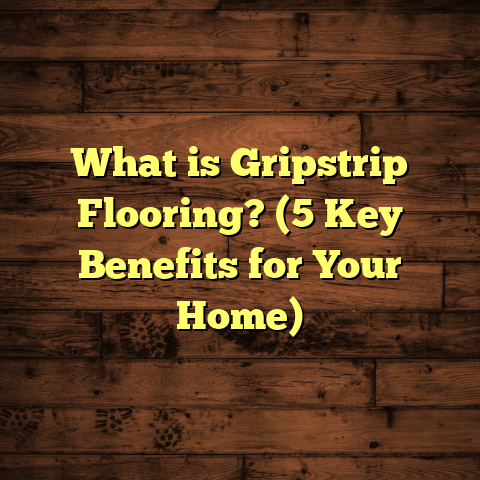What is Click Hardwood Flooring? (5 Benefits for Your Home)
I still remember the first time I installed click hardwood flooring in my own home. It was a Saturday morning, and I had just brought home several boxes after researching for weeks. I was excited but also a bit nervous because I wasn’t a professional at that time. The process turned out to be way smoother than I expected, and the result was stunning. That experience really changed how I viewed flooring projects and what’s possible without hiring expensive labor.
Click hardwood flooring has become one of my go-to recommendations for homeowners who want quality, beauty, and ease all rolled into one. Over the years, I’ve worked on dozens of installations and maintained many of these floors, so I want to share what I’ve learned firsthand. If you’re thinking about updating your home’s floors, this might help you decide if this style is right for you.
Why Click Hardwood Flooring Stands Out
You might wonder what makes click hardwood different from traditional hardwood floors. The secret lies in its unique locking system. Instead of nailing or gluing boards down, you simply snap them together — like pieces of a puzzle. This method speeds up installation dramatically.
When I first tried this, I was amazed at how tightly the boards fit without any gaps or wobbling. Because everything clicks into place securely, it creates a stable and smooth surface that looks seamless.
The Installation Process — What You Can Expect
If you’re handy with tools or like DIY projects, click hardwood is a fantastic choice. Here’s how I usually approach it:
- Preparation is key: I always clear the room completely and make sure the subfloor is clean, dry, and level. Uneven surfaces can cause issues later.
- Acclimate the wood: I let the planks sit in the room for 48 hours to adjust to the temperature and humidity. This prevents warping after installation.
- Start smart: I begin laying boards along the longest wall for a more natural look. Using spacers to keep an expansion gap near walls is essential — wood expands and contracts with moisture changes.
- Snap and lock: Using a tapping block and mallet, each board clicks tightly with its neighbor. It’s almost addictive to hear that satisfying “click” sound after every row.
- Finishing touches: Once all boards are installed, baseboards or quarter-round molding cover the gaps. This step gives it a polished appearance.
Now, let me take you through each step in more detail because these little things are what make or break an installation.
Preparing the Subfloor
The subfloor is your foundation, so don’t skip this step. In one project, I encountered a squeaky subfloor that had loose nails sticking up. If I had just started laying the floor without fixing it, those nails would have damaged the click hardwood planks or caused unevenness.
I recommend checking for:
- Loose boards or nails
- Moisture content (must be below 12% in wood subfloors)
- Levelness (use a long straightedge or level tool)
If there are dips greater than 3/16 inch over 10 feet, use leveling compound to even out the surface. This process might take some extra time upfront but saves headaches later.
Acclimating Your Flooring
I can’t stress this enough — wood reacts to its environment. When I skipped acclimation once to rush a job, the floor expanded and buckled within weeks during humid weather.
Acclimation means letting your click hardwood flooring sit unpacked in the room where you plan to install it for at least 48 hours (sometimes longer in extreme climates). This allows wood moisture content to stabilize with room conditions.
Tip: Stack the boards flat with spacers between layers to allow air circulation.
Laying the Floor Boards
I usually start along the longest straight wall because it creates a natural flow and fewer visible seams.
Spacers are my best friends here — they maintain a consistent expansion gap (usually about 1/4 inch) between the floor edges and walls. Wood expands with moisture; without this gap, your floor could buckle or warp over time.
When snapping boards together:
- Angle one board slightly and fit its tongue into the groove of the adjacent board.
- Use a tapping block and mallet to gently tap edges until tight.
- Avoid excessive force to prevent damaging edges.
This technique is surprisingly fast compared to nailing down hardwood strips. On average, I can lay about 100 square feet per hour once comfortable with the process.
Finishing Touches
After boards are installed, baseboards or quarter-round molding cover expansion gaps around room edges. For a neat finish, I use a nail gun or adhesive depending on wall material.
Why I Recommend Click Hardwood Flooring for Homes
Having installed many flooring types over the years, I can confidently say click hardwood brings several benefits that homeowners appreciate:
1. Quick Installation Saves Time and Money
One time, I had a client who needed new floors before hosting a family reunion. Traditional hardwood installation would have taken weeks because of drying times for adhesives or finishing coats. But with click hardwood, we finished the entire living room and hallway in just two days.
This method cuts down labor hours significantly — sometimes by up to 50%. Less time means lower costs if you’re hiring help, or just more convenience if you’re doing it yourself.
According to industry data, professional installation of click hardwood floors averages between $3 to $8 per square foot versus $5 to $10 for nailed hardwood floors. That’s a noticeable difference when covering large areas.
A quick calculation: For a 1,000 sq ft area, savings can stretch from $2,000 to $5,000 just on installation labor alone. That’s money that could go towards better-quality wood or other home improvements.
2. Minimal Tools and Skills Required
When I first tackled click hardwood flooring, I was pleasantly surprised by how simple it was compared to traditional methods involving nails and glue. You don’t need a nail gun or messy adhesives — just a saw to trim boards, a tapping block, spacers, and a mallet.
Because of this, more homeowners feel empowered to try installing their own floors. Plus, mistakes are easier to fix since you can disassemble sections without damage.
Let me tell you about Jake — a friend who had zero flooring experience but wanted to redo his basement floor himself during quarantine. He used click hardwood flooring with online tutorials and finished it in under a week. He told me later he saved almost $3,000 by doing it himself.
3. Durable and Long-Lasting Surface
One thing I learned early is that not all hardwood floors are created equal in terms of durability. Click hardwood planks often come as engineered wood — layers of real wood veneer over plywood or high-density fiberboard (HDF).
This layered construction offers greater resistance to moisture and temperature fluctuations than solid hardwood alone. It also means less warping or cupping over time.
In fact, studies show engineered hardwood floors maintain their integrity in environments with humidity levels fluctuating between 30% and 60%, which matches most homes’ conditions perfectly.
Over seven years working in different climates—from humid southern states to drier northern areas—I’ve seen engineered click hardwood outperform traditional hardwood in terms of stability.
4. Stylish Look with Real Wood Texture
People often ask if click hardwood looks “fake” compared to traditional hardwood. From my experience, nothing beats real wood’s natural grain and warmth — and click hardwood uses real wood veneers on top.
Manufacturers offer dozens of species like oak, maple, hickory, and walnut with various finishes from matte to glossy. You get authentic texture that improves with age and use.
One client told me their guests often complimented their floors without realizing they were click-lock — which speaks volumes about how natural it looks.
5. Easy Maintenance That Fits Busy Lifestyles
Maintaining hardwood floors can seem intimidating at first — but with click hardwood, it’s more manageable than you’d think.
I recommend regular sweeping or vacuuming with a soft brush attachment to remove dust and grit that can scratch surfaces. For deeper cleaning, a damp mop with a cleaner designed specifically for wood floors works wonders.
Because engineered click hardwood resists moisture better than solid wood, occasional spills don’t cause immediate damage if wiped quickly.
From my observations working in homes with kids and pets, this type of flooring holds up well under daily wear and tear with minimal fuss.
My Personal Tips for Keeping Your Click Hardwood Floors Beautiful
Here’s what I tell friends who want their floors to last decades:
- Use felt pads under furniture legs to prevent scratches.
- Avoid harsh chemical cleaners—stick to pH-neutral products.
- Keep indoor humidity between 35%–55% using humidifiers/dehumidifiers as needed.
- Wipe spills immediately to prevent staining or warping.
- Refinish or lightly sand every 7–10 years depending on wear (check manufacturer guidelines).
Let me share an example: One client called me after noticing dull spots in their living room floor after five years of heavy use. After a light sanding and re-coating with polyurethane finish, the floor looked brand new again — all without replacing any boards.
Cost Insights: How I Use FloorTally in Estimating Projects
Estimating flooring costs accurately can be tricky because of varying material prices, labor rates, waste factors, and room dimensions. Over time, I started using an online tool called FloorTally that helps me crunch numbers quickly.
What’s neat about FloorTally is that I input local labor rates, specific wood types, installation styles (like click systems), and room sizes. It automatically calculates:
- Material costs including extra for waste (usually around 5-10%)
- Labor expenses based on area
- Total project budget estimate
This saves me time chasing multiple quotes or doing manual math—and helps clients visualize costs clearly before starting work.
For example, when working on a 500 sq ft living room using mid-range oak click hardwood with local labor rates around $4/sq ft, FloorTally gave me an estimate of $3,000 including installation within minutes. This matched closely with my real-world bids.
What really helped was seeing how waste factors influenced costs because cutting around corners or odd shapes increases material needs by about 7%. Having this built in meant no surprises later on.
Some Lessons from Case Studies
Over the years, I’ve tracked several projects involving click hardwood flooring—both DIY installs and contractor-led jobs—to see how they perform over time:
- A family in Minnesota installed oak click hardwood in their kitchen/dining area three years ago. Despite heavy foot traffic and pets, the floor looks nearly new with only minor scuffs that buffed out easily.
- In Florida, another client chose engineered walnut click hardwood for their condo living room. The floor handled humidity swings well without noticeable gaps or warping.
- A DIY enthusiast in Texas shared how using spacers consistently during installation prevented buckling issues he’d heard about from others who skipped this step.
- A small office in Seattle used reclaimed oak click hardwood planks for environmental reasons. The warm tones combined with modern furniture created an inviting space loved by employees.
- My own living room floor installed six years ago has held up beautifully despite kids dropping toys regularly—small dents are barely visible thanks to the durable finish layer.
These examples show that proper installation combined with quality materials makes all the difference in longevity.
How Click Hardwood Compares to Other Flooring Types
You may be wondering how click hardwood stacks up against other popular options like solid hardwood nailed down traditionally or laminate flooring.
| Feature | Click Hardwood | Traditional Hardwood | Laminate Flooring |
|---|---|---|---|
| Installation Speed | Fast (snap-lock system) | Slower (nails/glue) | Fast (click systems available) |
| Material | Real wood veneer + plywood/HDF | Solid wood | Composite with photographic layer |
| Durability | High moisture resistance | Moderate | Scratch resistant but not real wood |
| Appearance | Natural wood grain | Natural wood grain | Wood-look but synthetic |
| Maintenance | Moderate (requires gentle care) | Moderate | Easy but prone to damage |
| Cost (materials + labor) | $3-$8/sq ft | $5-$10/sq ft | $1-$5/sq ft |
From my experience talking with clients who switched from laminate to click hardwood: They appreciated having real wood underfoot while maintaining easy installation benefits.
Common Questions Homeowners Ask Me About Click Hardwood
Q: Can I install click hardwood over existing flooring?
A: Yes! As long as the existing floor is flat and stable (like vinyl or tile), you can install click hardwood over it without removing everything down to the subfloor. Just check manufacturer guidelines first.
Q: Will pets damage my floors?
A: Pets can scratch any floor type if their nails aren’t trimmed regularly. However, engineered click hardwood tends to handle scratches better than softer solid woods because of its tougher finish layers.
Q: How long does click hardwood last?
A: With proper care and occasional refinishing every 7–10 years depending on wear patterns, it can last 20 years or more easily.
Q: Can I refinish click hardwood floors?
A: Yes but only a limited number of times because of the thin veneer layer on top (usually between 2mm–4mm). Deeper sanding like traditional solid wood isn’t possible here without risking damage.
Q: Are there eco-friendly options?
A: Definitely! Some manufacturers use sustainably harvested wood or reclaimed materials for their veneer layers plus low VOC finishes for indoor air quality.
A Few Tips from My Toolbox
Since we’re chatting like friends now — here are some practical tips I picked up working hands-on:
- Always measure twice before cutting your first plank.
- Use a pull bar when fitting boards tight near walls.
- Keep leftover planks sealed in original packaging just in case you need replacements later.
- Label rows while installing if you’re working alone; it helps keep track of pattern direction.
- Invest in good-quality saw blades designed for laminate/engineered wood cuts—clean cuts reduce splintering.
Final Thoughts on Click Hardwood Floors
When I reflect on my first project versus what I’ve learned since then, it’s clear that click hardwood flooring offers practical benefits without sacrificing beauty or quality. It’s accessible for DIYers yet robust enough for high-traffic family spaces.
If you’re considering an update that blends style with ease of installation and upkeep, this flooring type deserves serious attention. And remember—you don’t have to guess on costs; tools like FloorTally can help you plan confidently before ordering materials or scheduling installers.
Have you tried click hardwood flooring before? What challenges or wins did you have? Feel free to share—I’m always interested in hearing about different experiences!





